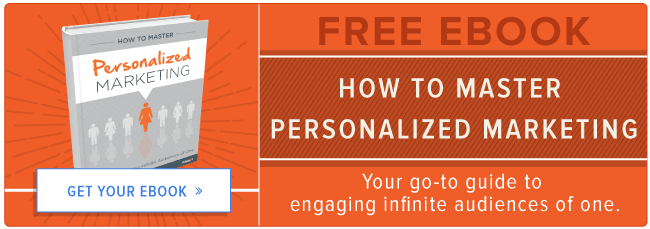 We’re now encountering more personalized experiences than ever before. Before, it was just your favorite coffee shop barista who greeted you by name. Now, your News Feed is customized to your interests and behavior, your online purchases are largely influence by what Amazon’s algorithm think you’d like, and you can’t open up an email without it saying, "Hi [First Name]."
We’re now encountering more personalized experiences than ever before. Before, it was just your favorite coffee shop barista who greeted you by name. Now, your News Feed is customized to your interests and behavior, your online purchases are largely influence by what Amazon’s algorithm think you’d like, and you can’t open up an email without it saying, "Hi [First Name]."
You can thank technology for all of that. It’s made it easier and easier for companies to personalize their products, services, and marketing to individuals — but it’s also risen consumer expectations. In fact, a study by Janrain showed that 74% of online consumers get frustrated with websites when content appears that has nothing to do with their interests.
As a marketer, you need to be prepared to offer personalized experiences to your audiences — and we’re not talking about adding someone’s first name in the greeting of your next email send. Keep on reading to discover a few ways you definitely should be personalizing your marketing.
1) Cater to individual personas.
Your website should be catered to different buyer personas and serve relevant content to individuals in your core personas. For example, let’s say you sell time management software and you have two very different personas. The first is HR Harry who is looking at any of his hourly employees times and any concerns with time and payment are correct. The second is Independent Contractor Isabella who is consistently monitoring time to ensure she is as productive as possible, and she appropriate stays within her project limits.
How would you personalize your website for each of these personas? To start, think about your homepage, where all of your visitors get a first impression of your business. Utilize CTAs, content, and imagery that specifically address your main personas’ needs and interests. In the context of the previous example, if we were personalizing our pricing page, we’d want to show HR Harry information on employee time management. Independent Contractor Isabella, on the other hand, should be shown information about personal project time tracking.
2) Display different content based on social referral source.
The referring location a visitor comes from can tell you a lot about what they are interested in. If a visitor comes from a Twitter link, for example, they may prefer to read shorter-form content and have shorter forms that allow you to quickly capture their attention and then move on. However, if a visitor comes from The New York Times they may prefer more thorough or in-depth explanations that contains more detail.
So how should we actually personalize these experiences?
Look at your top referral sources for one high-trafficked page, and then tweak messaging, content length, and imagery (among other things) for each referral source. If that is successful, then try scaling the personalization strategy to other landing pages with high traffic.
3) Show a unique experience to first-time website visitors.
When a new visitor comes to your website and you don’t have any of their contact information, how do you deliver an experience that delights them?
Because each device connected to the Internet has a IP addresses, you can use this IP address to get a general idea of where your visitors are coming from. As a result, if you have a significant number of visitors in the U.S. and Germany, you can show visitors from Germany a version of page written in German. Or, you could show "Contact Us" information to get someone in touch with an office more local to them.
You can also try personalizing based on the device someone’s using. For example, you can show visitors coming from smartphones shorter-form content and the ability to send any offers to themselves via email (rather than download them directly).
4) Nurture individuals through your funnel with lifecycle stage specific content.
If you’re using email to nurture prospects through your buyers journey, why shouldn’t your webpages also be personalized for each of these steps along the journey, too?
You should change headline messaging on your homepage to show different copy to people in different stages of the buying journey. This is how we’d do it if we were working for a landscaper:
- Visitor: Prepping your house for winter is a tough task. Download this free checklist to make sure you’re not forgetting a thing.
- Marketing Qualified Lead: We’ve helped over 80 customers with fall cleanup. Find out how we can help you!
- Customer: Welcome back! It’s time to schedule your next appointment.
Going beyond just headlines, you can display completely different content to each of these groups to tailor the experience. This personalization to individuals and tailoring to the needs at that time in the buyer’s journey helps make your page far more relevant and more likely to generate the desired results.
How else are you using personalization? We’d love to hear your ideas below.
![]()




